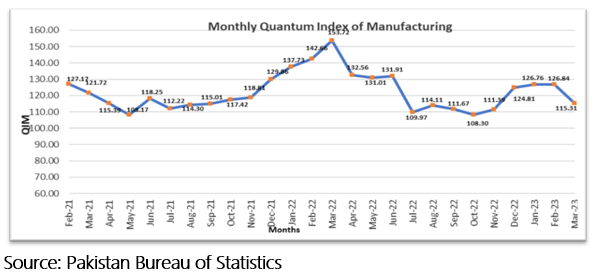INP-WealthPk
Ayesha Mudassar
Tight monetary policy, import controls, record monsoon rains, price hikes, and political climate are the significant factors that have adversely affected the country’s agriculture and manufacturing sector. It is due to these factors that the provisional GDP growth rate for the Fiscal Year 2023 is estimated at 0.29 percent.
Agriculture
Agriculture – the backbone of rural economy – is short on growth. According to the monthly Economic Update and Outlook for May 2023, important crops have witnessed a decline of 3.2 percent. Cotton registered a decrease of 41 percent and rice 21.5 percent. However, a positive growth has been recorded in the production of wheat, sugarcane, and maize. Wheat production increased by 5.4 percent, sugarcane by 2.8 percent, and maize by 6.9 percent.
The provisional growth in livestock, forestry, and fishing stood at 3.78 percent, 3.93 percent, and 1.44 percent. Talking to WealthPK, Muhammad Alamgir Chaudhry, CEO of the National Productivity Organization (NPO), said the agriculture sector has enormous potential to solve the country's economic woes by reducing dependence on imports, expanding exports, and driving growth in other sectors. However, the sector has been hit hard as a result of heightened inflation, torrential rains in 2022, and high electricity tariff.
Manufacturing sector
Large Scale Manufacturing (LSM) – a key indicator of industrial activity – witnessed contraction owing to various factors such as supply chain disruptions, inflationary pressures, and unfavorable global economic conditions. The LSM output plunged by 25 percent in March 2023 when compared with March 2022 and 9.09% when compared with February 2023.

Overall, the Large-Scale Manufacturing (LSM) sector has shown a decline of 8.11% during July-March 2022-23 compared with the same period of the last year. The main contributors to this decline are food (-1.62), textile (-3.16), tobacco (-0.57), petroleum products (-0.68), cement (-0.85), pharmaceuticals (-1.30), and automobiles (-1.85). Talking to WealthPK, Secretary Auto Industry Development Committee (AIDC) Engineer Asim Ayaz said the performance of the auto industry also remained subdued due to immense increase in input prices, tight auto financing, and import restrictions.
According to the Pakistan Automotive Manufacturing Association (PAMA), car production and sales decreased by 50.5 percent and 53.7 percent. Moreover, trucks and buses production and sales decreased by 36.2 percent and 34.8 percent over the Jul-Apr period this year. Chairman Pharmaceutical Manufacturers Association (PMA) Syed Farooq Bukhari told WealthPK that the manufacturers are witnessing a tremendous rise in the cost of production.
“The eroding rupee value and dwindling foreign exchange reserves have significantly reduced the country’s ability to import active pharmaceutical ingredients used in domestic production which consequently lowers pharma output,” he said. Textiles – the largest manufacturing industry – also observed the same situation.
Credit: Independent News Pakistan-WealthPk




